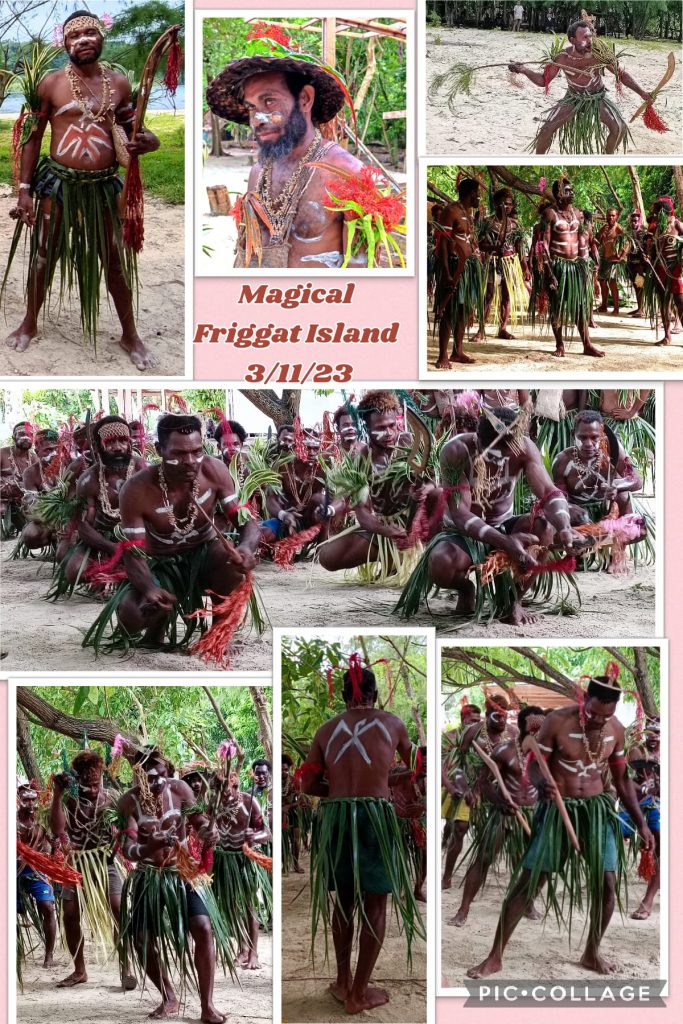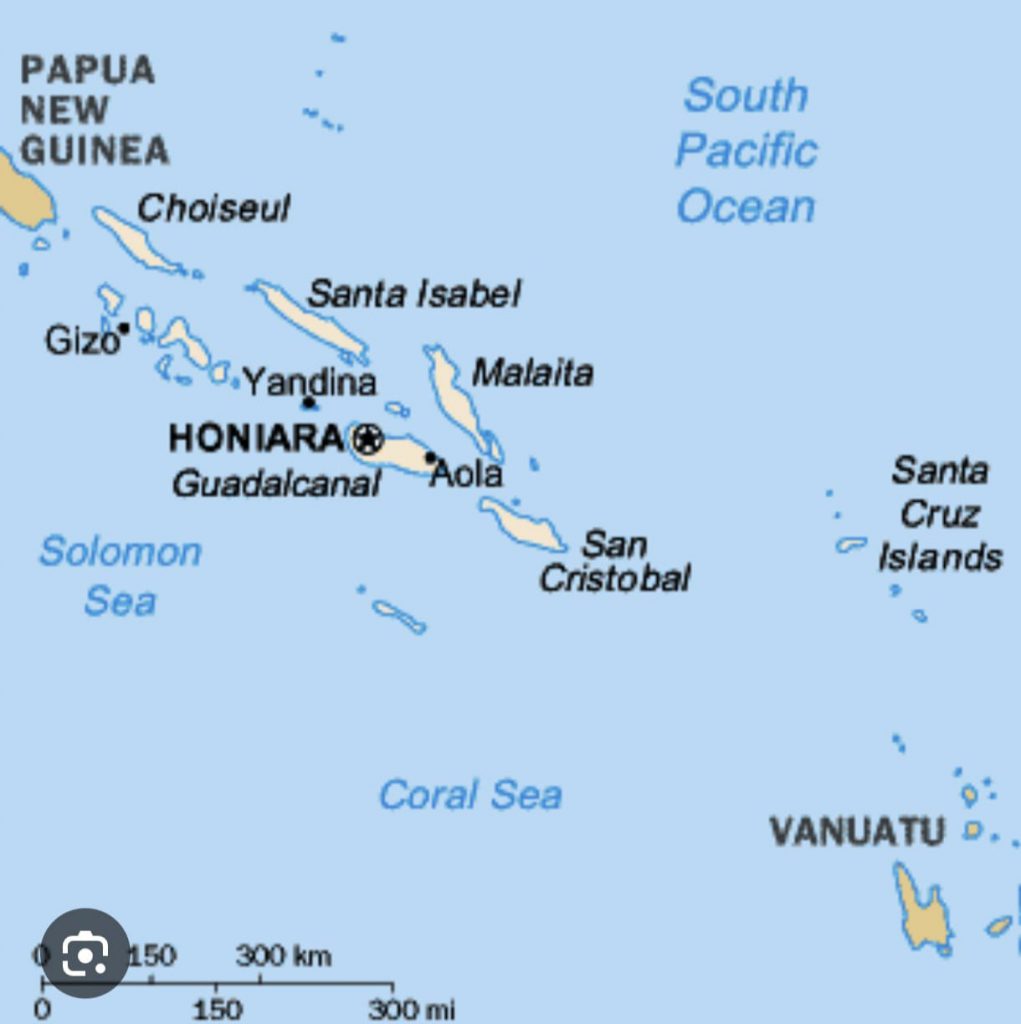
Solomon Islands (also known as the Solomons) consists of six major islands and over 900 smaller islands in Melanesia, part of Oceania, to the northeast of Australia. The country has an area of over 28,000 km2 and an estimated population of 750,000. Honiara located on the largest island, Guadalcanal is the capital and largest city. First discovered by a Spanish explorer in 1568, British captain Herbert Gibson of HMS Curacoa declared the southern Solomon Islands a British protectorate in 1893. There was fierce fighting between the US, British and Japanese forces during the WWII (known as the Solomon Islands campaign 1942-1945). The official name of the then British administration was changed to “The Solomon Islands” in 1975 and self-government was achieved in 1976. Independence was obtained in 1978.
October 31 Tuesday Kolombangara

We saw the extinct cone volcano of Kolombangara, an island with an area of 687 km2 in the New Georgia Islands, when we got up. The heavily forested island with few inhabitants, is a stratovocano reaching a height of 1,770 metres. The Imperial Japanese army had used an airstrip on the southern shore of the island and over ten thousand Japanese troops were present in May 1943. Today, the most significant industry on the island is logging.
At the invitation of the Kolombangara Island Biodiversity Conservation Association, we spent the morning visiting the conservation area located 400 metres above a sustainable forest plantation with an area of 200 km2. The Association arranged three 10-ton trucks to take us up to the Imbu Rano Lodge. The energetic and intrepid passengers set off on a long walk into the thick rainforest. I joined a short forest walk led by Rod, our naturalist looking for ant plants, a variety of orchids, insects and reptiles. The birders looked for Roviana Rail on their must-see list.
On departure, a bamboo band performed for us near the landing site. The villagers from Rinaggi and Boboe displayed and tried to sell polished wood bowls and elaborate masks. After a quick lunch on the ship, we had a swim and snorkeled off the beach on Lilly’s Island. We also had a zodiac cruises in the lagoon and up to the nearby river complete with dolphin escorts. I joined a group and had an informal and interesting visit to a small village. By 5:30pm, we were all back onboard and departed for Tetepare Island.

© S. Bradley, Heritage Expeditions 
November 1 Wednesday Tetepare Island
Tetepare, a long rugged island with an area of 118 km2 is noted as the largest uninhabited island in the South Pacific showcasing unique terrestrial and marine animals protected by a permanent Marine Protected Area. The people of the island decided to establish the Tetepare Descendants’ Association to protect the environment and culture of the island with a focus on conservation of the green and hawksbill turtles and critically endangered leatherback, dugongs, sharks, crocodiles, rare birds and bat species and manage the island’s resources sustainably. The coral reefs of the region support one of the highest diversities of fish and coral in the world, second only to Raja Ampat in Indonesia.

We were welcomed by local rangers in a dramatic fashion: dressed in their traditional attire complete with bows, arrows and axes, they gave us a warrior greeting leading us breaking into laughter! We were delighted to watch the gigantic Coconut Crabs that climb trees.
We split into groups. My group first went to the black sand beach where a local ranger explained the turtle conservation programme. We watched a green turtle swimming back to the sea. Then we had a short walk in the forest. I also had a drift snorkel along the fringing reef before boarding the ship. There were both hard and soft corals on the reef with plenty of large fish such as Snapper, Parrotfish and Grouper. Owing to the swell, I did not see too clearly as the water was not tranquil and crystal clear. We were back on the ship by 12 noon.
In the afternoon we had talks on reefs and ship superstition. In one of the sessions, some of the speakers expressed their views on the increasing Chinese activities, influence and threats in general, and the Solomons in particular. I stood up and told the audience that Chinese have been sailing to and trading in Africa and the Pacific well before the age of European exploration. While the Portuguese, Dutch, Spanish, German and British claimed sovereignty, the Chinese have been peaceful migrants and traders. I felt the westerners had looked at China and the Chinese through their prism and invasive colonial past.
November 2 Thursday Malaita Island
Malaita Island, the second largest and most populous island of the country, is famous for its music and dance sometimes associated with rituals. Shell money is still used as bride price, for funeral feast, compensation etc. In the morning, we snorkeled from an uninhabited Leli Island. The snorkel was fairly good. I also had a short walk in the forest following Rod, our naturalist.
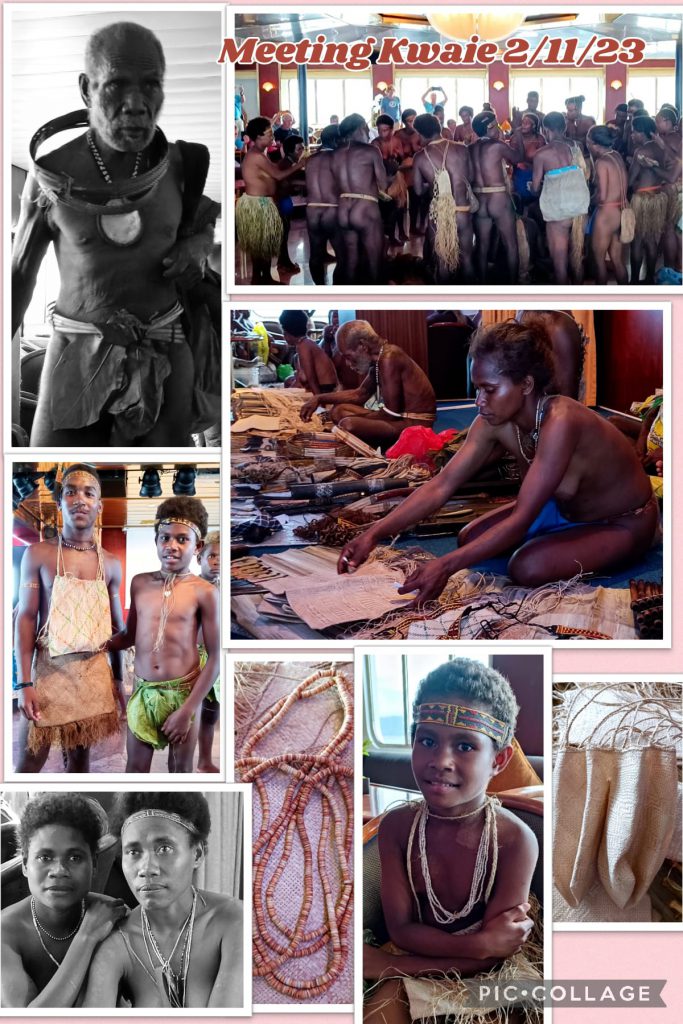

© S. Bradley, Heritage Expeditions

In the afternoon, we welcomed Chief Esau from the Kwaio community and some of his dance troupe aboard in their traditional attire. As a result of an atrocity in 1927, this community fled to the mountain to maintain their traditional ways of living. They took two days to come down the mountain to greet us. The original plan was to meet them on Leli Island where they would perform their very sacred dances away from the eyes of any coastal tribes. However, a tribal dispute over land ownership of the island broke out and the group was not allowed to perform on there. As a result, they came to our ship to perform. After watching them dancing, we were invited to join in one of their sacred dances which can only be experienced by those wearing the traditional attire. A small but dedicated group of the passengers took part casting off their inhibitions and clothes for this unique experience. I gave it a miss!
Around 4 pm, we were arranged to visit the Ngongosils Island which was not on our original programme. Some 300 inhabitants live in this small island. We watched some spectacular performances by young boys and a traditional bridal ceremony. The villagers including those coming from nearby islands, were most enthusiastic. They showed us around, looking at neat houses and two churches. I noticed there was a dozen of pigs and two toilet complexes with all droppings / waste going straight to the sea. Sanitation is a real issue!
November 3 Friday Star Harbour and Frigate Island
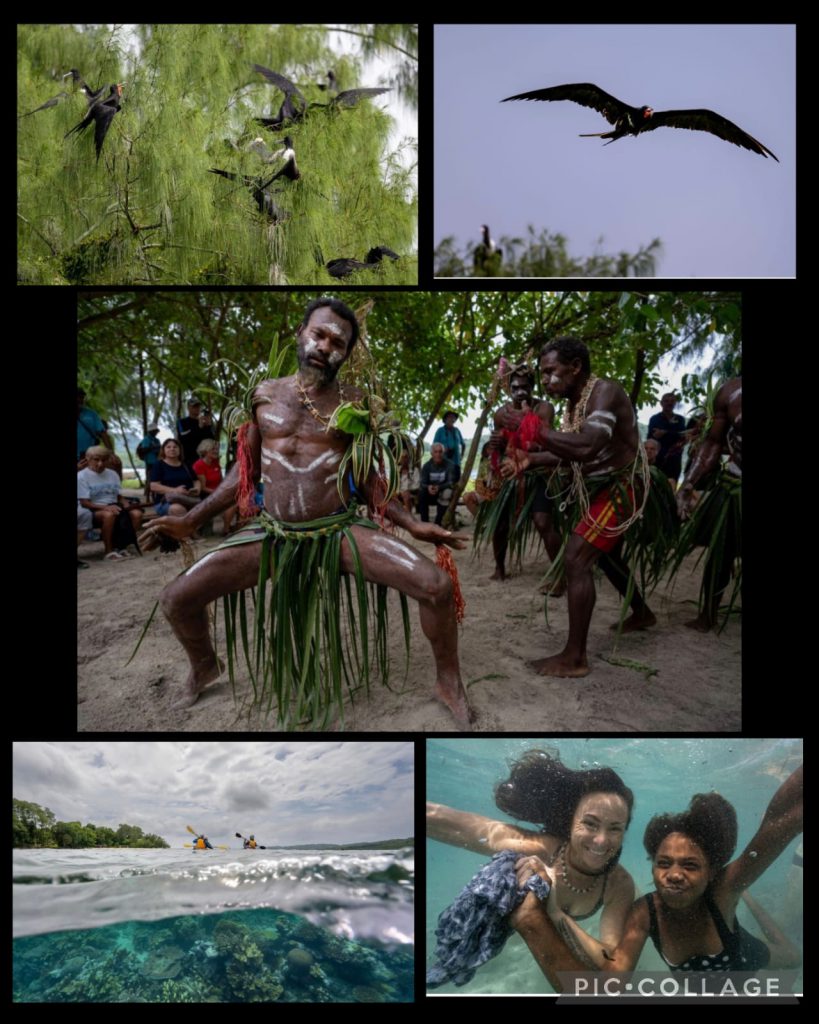
© S. Bradley, Heritage Expeditions 
We anchored off the entrance of Star Harbour near the Frigate Island. We went ashore after breakfast and were greeted by the locals with speeches and welcome dance. Hundreds of Lesser Frigate birds circled above our heads and perched in the tall trees.
I walked around this small island which only had several thatched wooden buildings. There were a few Magapode birds on the island. I snorkeled off the beach and had a good time gazing at beautiful soft corals and the fish. We were back on the ship before noon. In the afternoon, Beth and Bruce talked about PNG and WWII followed by a panel discussion with Rod, Lou and Beth on the future of conservation in Melanesia.
November 4 Saturday Nendo Island, Santa Cruz Islands

Nendö (also known as Santa Cruz) is the largest of the Santa Cruz Islands. During the Pacific campaign of WWII, the Battle of the Santa Cruz Islands was fought north of the Santa Cruz group and some US Navy seaplanes were based in Graciosa Bay. These islands were affected by the 2013 Solomon Islands earthquake and subsequent tsunami.
We went ashore at Nemboe Village around 8 am and were greeted with traditional welcome dance and women’s dance on the beach. Then torrential rain came and went without dampening their enthusiasm. We had another traditional dance in the village proper. The villagers set up market booths which showed everything from carvings to the manufactured of Red Feather Money which is used in the Santa Cruz Islands as a form of currency in settling important obligations in bridal wealth etc. This currency known as ‘Tevau’, is formed as coils resembling long belts and can reach up to 10 metres long. The feathers come from the head, breast and back of a small Scarlet Honeyeater birds living in the rainforest. A double coil of currency may consist of around 50-60,000 red feathers. I met a nice girl who became my personal guide who now runs the government guest house in the village. Her grandfather who is almost 100 years old, was one of the chiefs and I took photos with her family.
In the afternoon, we visited a technical college where students learned vital skills in house building and construction. We walked along the coast and arrived at the predominantly Anglican village notable for its monastery. By 3:30pm, we waved goodbye to the Solomons heading to the last country on our voyage, Vanuatu.
Vanuatu 5 – 8 November
Vanuatu is a small island country comprising over 80 islands in Melanesia with an area of 12,189km2 and a population of about 345,000. The Spanish explorer arrived in 1606 and claimed it for Spain. In the 1880s, France and the UK claimed parts of the archipelago, and in 1906 they agreed on a framework for jointly managing the archipelago as the New Hebrides through an Anglo-French condominium. In 1970s, an independence movement arose leading to the establishment of the Republic of Vanuatu in 1980.
November 5 Sunday Loh Island, Torres Islands

We went ashore after clearance by the Vanuatu Customs officials who came aboard around 8:30am. We had a warm Vanuatuan welcome with drums when we landed on a secluded beach in the village of Rinuhe on Loh Island which is one of the main exporters of coconut crabs. Heritage Adventure was the first expedition ship to visit after her visit last year. We were adorned us with beautiful leis and greeted by the chief of the local village and wider community before beginning in dances. We were invited to join. Their dance routines involved different generations tramping out a circular beat in the show of unity. We were delighted to sample the local delicacies.
After the dance we split into groups to visit different parts of the island. I joined a group to visit a big cave before walking to the other side of the island which has a most beautiful with sheltered beaches. After lunch, we had our first snorkel. By 3:30pm the ship set sail for Espiritu Santo. We had three lectures by Bruce on WWII history, Valerie on chocolate and Rod on Island dispersal.
November 6 Monday Espiritu Santo
Espiritu Santo with an area of 3,677km2 is the largest of Vanuatu’s islands. It is known for its white soft sand beaches and clear blue waters. We spent a morning on the most beautiful Champagne Beach. We snorkeled out from the beach and the marine life was fantastic. We were treated with champagne instead of coffee and tea!
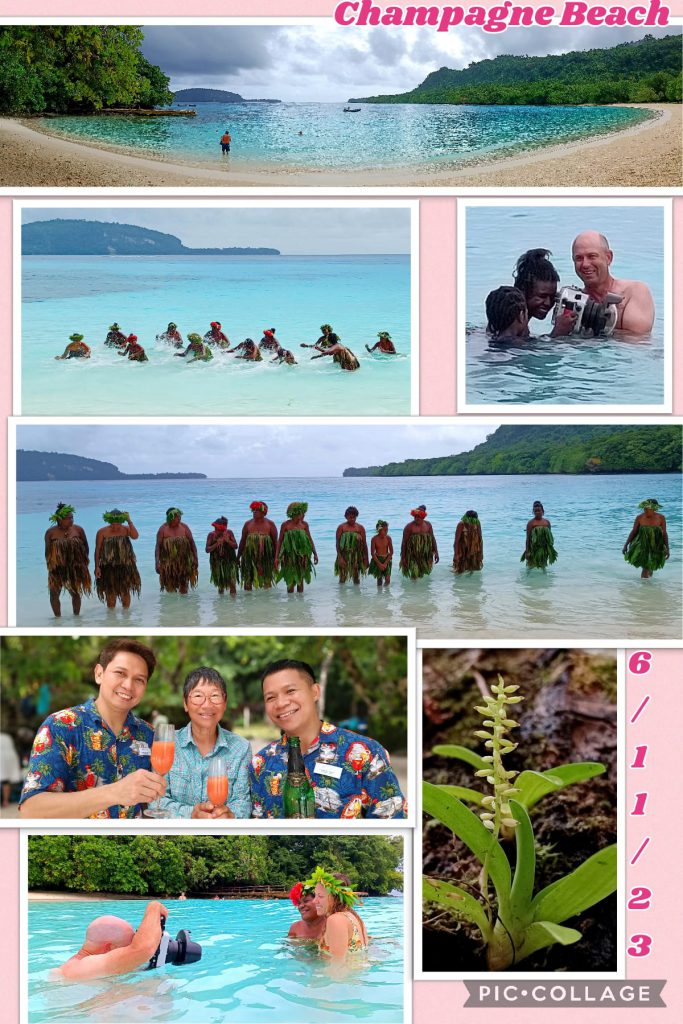

© S. Bradley, Heritage Expeditions
The highlight of the morning was an incredible water music of the Leweton Village water dancers from Gaua Island in the Banks Islands. The water music has been practised on Champagne Beach for hundreds of years and is passed on through the Ni Vanuatu women. In 2008, they became famous worldwide through a tour of Europe, Australia, Asia and the USA.
By the afternoon, we re-positioned further down the coast and explored Santo and downtown Luganville, the provincial capital. During WWII particularly after the Japanese attack on Pearl Harbour, the island was used by Allied Forces as a military supply and support base, naval harbour and airfield. We visited the Million Dollar Point, named for its worth after thousands of tons of US construction equipment was dumped into the sea after WWII. We stopped at the memorial site of the SS Coolidge – an American luxury ocean liner that was converted into a troop carrier during WWII and sank as a result of hitting two US mines. The SS Coolidge and the Million Dollar Point are both world-renowned dive sites on Espiritu Santo.

The highlight of the afternoon was the Blue Holes – crystal-clear, deep iridescent blue pools unique to Vanuatu. These natural phenomena are formed when underground streams originating in the island’s western ranges resurface as spring, cutting deep circular pools into the karst. Filtered by limestone, the water in these holes is pure and gin-clear, manifesting in luminous shades of blue. What I enjoyed most was the downriver journey on zodiac through spectacular jungle that took us to the sea and finally back to our ship. We had a great BBQ aboard in the evening.
November 7 Tuesday Ambrym Island
Ambrym Island translating into “here are yams” was named by Captain Cook who anchored here in 1774. It is a ‘black’island due to its volcanic ash and because of its ‘black magic’ history. Ancient customs play a significant part in everyday village life including unique characteristics such as sculpted tam-tams (silt gongs), sand-drawing, tree fern statues and local mystical dances. Cyclone Lola named on 22 October 2023 was the strongest off-season tropical cyclone in the Southern Hemisphere with the greatest impact on Vanuatu. Pentecost, Malakula and Ambrym had been severely affected with 50% of homes damaged. Upon hearing the plight of the people, some passengers and staff donated US2,000 to provide food and water (140kg of rice, 3,000 litres of water in 20-litre containers, soap, medical supplies and another 300kg of food from the ship) for the Ambrym community.

© S. Bradley, Heritage Expeditions
A highlight of a visit to Vanuatu is the Rom Dance that is a sacred initiation celebration for young men taking the rites of passage into manhood. We landed at Nobul Village around 8:30am. While the fit guests spent 30-45 minutes to walk to the dance site, old and weak guests had a ride on a 4WD. I could see the damage to houses, gardens and commercial crops such as coconut trees when we drove along the road. The locals had done an excellent job of clearing up the performance site. After initial speeches, we witnessed some storytelling and sand drawing before the 30-40 Rom Dancers slowly appeared with their mesmerising beat. The captivating sound created by resonating beats, dancers’ stepping on the hard soil and rhythmic chanting, special attires, mysterious movement and gestures created the most spectacular performance of the expedition.
In the afternoon, we had lectures before attending Captain Tomasz’s farewell cocktail and dinner. A highlight was the slide show of the 16-day journey made by Stephen Bradley, our photographer on the ship.
November 8 Wednesday, Havannah Harbour, Vanuatu – Sydney, Australia
The journey came to an end after sailing more than 2,480 nautical miles over 16 days with 15 expedition stops. After breakfast, we disembarked while some passengers, few crew and expedition team members who would disembark in New Zealand, stayed on. I bid farewell to my friends, the friendly and dedicated crew and enthusiastic expedition team members. We were dropped off in a hotel where we could relax before going to the airport. My flight to Sydney took off as scheduled at 4 pm and I spent a few days with Alan, my brother and Vicki, my sister-in-law before returning to on 12 November.
Remarks
The Bali-Vanuatu expedition on Heritage Adventure from 7 October to 8 November is the third longest sea voyage I have taken so far. I appreciate the travel log and photos provided by Heritage Adventure. I have used the materials and images extensively when writing my travel notes six months after the voyage. My own photos along side with those from S. Bradley, our professional photographer, give me an opportunity to refresh my memories of this wonderful journey and reflect. Here are a few lasting thoughts and impressions.
First, it was my first long expedition in warm waters and I thoroughly enjoyed the warm sunny weather. Heritage Adventure is a comfortable expedition boat. The expedition team was wonderful with a few star speakers.
Second, the pristine water and beaches, rich coral, marine life and vegetation in Indonesia, PNG, Solomon Islands and Vanuatu are unsurpassed. I love to return to Raja Ampat one day.
Third, the cultural and bio-diversities, and ethnic groups of the whole region are mind-blogging. Personal experience is the only way one can get a glimpse of and appreciate this part of the world that has yet to be spoilt by modernisation and over-development. I try not to over-romanticise and should point out that most of the people are struggling in subsistence economy and living below the poverty line and without proper health and social services. They are neglected by their central government and subject to natural calamity such as earthquake, tsunami and hurricane etc. Despite that, the people carry on their simple life with dignity. They care about their rustic and simple home that is often adorned with plants. The environment is fragile and their practice of using charcoal is a concern. Illegal logging and overfishing are serious problems. Sustainability is a key issue for the whole region and their future.
Finally, the presence of China and economic dominance of Chinese enterprises in the region has been mentioned in lectures and other occasions. Being the only Chinese onboard, I was sad to note their phobia and suspicion. I can understand the western mentality and their sense of superiority. However, I don’t think Chinese are traditionally imperialists or colonizers (as what the European powers have done since the 15th century) as evidenced in Chinese 2000-year of history. Only time can tell!


